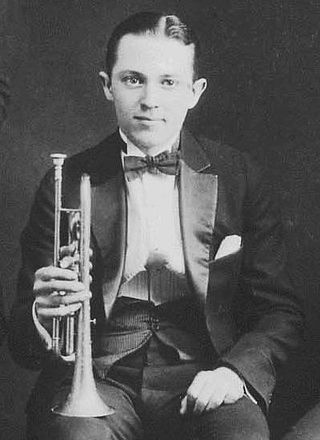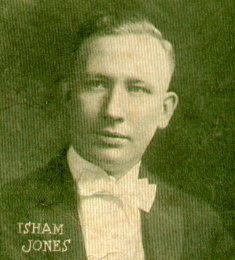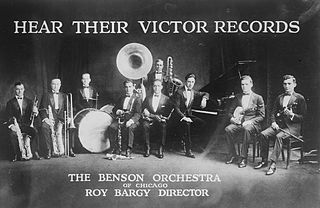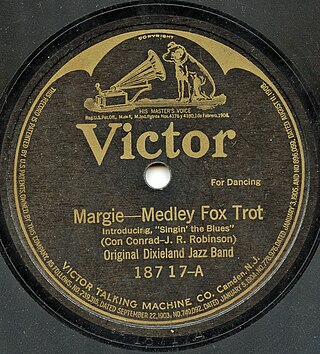
Ray Miller (1896–1974) was an American bandleader who was popular during the 1920s. In 1924 his orchestra performed at the White House with Al Jolson, the first jazz band to do so.

Ray Miller (1896–1974) was an American bandleader who was popular during the 1920s. In 1924 his orchestra performed at the White House with Al Jolson, the first jazz band to do so.

Relatively little is known of Miller's private life. He may have been born in Reading, Pennsylvania. In 1916, he worked as a singing waiter at the Casino Gardens in Chicago, home of the Original Dixieland Jazz Band (ODJB). Miller followed the ODJB to New York City, where he formed a band, the Black and White Melody Boys, featuring himself on drums and New Orleans native Tom Brown on trombone. The band performed in vaudeville and featured in several musical productions before disbanding. [1] [2]
Miller formed a dance band around 1920. Its members, at different times, included Ward Archer (drums); Charlie Rocco (trumpet); Miff Mole (trombone); Danny Yates (violin); Roy Johnston (trumpet); Rube Bloom and Tommy Satterfield (piano); Louie Chasone (tuba); Frank Trumbauer, Andy Sannella, Billy Richards and Andy Sandolar (saxophones); and Frank O. Prima (banjo). The orchestra recorded for various labels, notably Columbia and OKeh, before signing an exclusive contract with Brunswick Records in late 1923. They increasingly played jazz-influenced music — especially after Mole and Trumbauer joined in 1924 [2] — and held residencies at the New York Hippodrome and Arcadia Ballroom, and in Atlantic City. [1] [3] The orchestra's most successful recordings included "The Sheik of Araby" (OKeh, 1922), "I'll See You In My Dreams" (Brunswick, 1925), and "When It's Springtime in the Rockies" (Brunswick, 1930). "I'll See You In My Dreams" was written by Isham Jones, who performed it with the band. [4]
On October 17, 1924, the orchestra became the first jazz band to play at the White House, where they performed with Al Jolson at a campaign rally for President Calvin Coolidge. [3] They also recorded with Jolson, notably on Irving Berlin's song "All Alone" in late 1924. [5] After Mole and Trumbauer left, Miller moved his base to the Hotel Gibson in Cincinnati, Ohio, in 1927, and performed regularly for the powerful radio station WLW. He left Cincinnati and formed a new band in Chicago in 1928, which for a few months included trumpeter Muggsy Spanier [2] and clarinetist Volly De Faut. Miller and his orchestra recorded regularly for Brunswick in Chicago until 1930. [6]
Miller left the music business sometime after 1930. His later life is not publicly recorded, but it has been suggested that Miller invested heavily into the Stock Market before 1929, and lost a good deal of money after the markets crashed in October of that year. [2] He is believed to have died in 1974.[ citation needed ]

Leon Bismark "Bix" Beiderbecke was an American jazz cornetist, pianist and composer.

The Original Dixieland Jass Band (ODJB) was a Dixieland jazz band that made the first jazz recordings in early 1917. Their "Livery Stable Blues" became the first jazz record ever issued. The group composed and recorded many jazz standards, the most famous being "Tiger Rag". In late 1917, the spelling of the band's name was changed to Original Dixieland Jazz Band.

Ernest Loring "Red" Nichols was an American jazz cornetist, composer, and jazz bandleader.

Barnett, Kyle (2020). Record cultures: the transformation of the U.S. recording industry. Ann Arbor, [Michigan]: University of Michigan Press. p. 42. ISBN 978-0-472-12431-2.

Isham Edgar Jones was an American bandleader, saxophonist, bassist and songwriter.

Irving Milfred Mole known professionally as Miff Mole, was an American jazz trombonist and band leader. He is generally considered one of the greatest jazz trombonists and credited with creating "the first distinctive and influential solo jazz trombone style."

Orie Frank Trumbauer was an American jazz saxophonist of the 1920s and 1930s. His main instrument was the C melody saxophone, a now-uncommon instrument between an alto and tenor saxophone in size and pitch. He also played alto saxophone, bassoon, clarinet and several other instruments.

The Dorsey Brothers were an American studio dance band, led by Tommy and Jimmy Dorsey. They started recording in 1928 for OKeh Records.

"I'll See You in My Dreams" is a popular song and jazz standard, composed by Isham Jones, with lyrics by Gus Kahn, and published in 1924. It was recorded on December 4 that year, by Isham Jones conducting Ray Miller's Orchestra. Released on Brunswick Records, it charted for 16 weeks during 1925, spending seven weeks at number 1 in the United States. Other popular versions in 1925 were by Marion Harris; Paul Whiteman; Ford & Glenn; and Lewis James; with three of these four reaching the Top 10.
"The One I Love (Belongs to Somebody Else)" is a popular song composed by Isham Jones with lyrics by Gus Kahn. The song was recorded by Isham Jones' Orchestra on December 21, 1923, at Brunswick Studios in New York City, and published on January 7, 1924. On January 17 in Chicago, Jones recorded another version, with Al Jolson on lead vocals. Both versions made the charts that Spring, with Jolson's peaking at number 2, and Jones' at number 5. Sophie Tucker recorded her version February 1924, released on Okeh 40054.

"Mississippi Mud" is a 1927 song written by Harry Barris, first sung by Bing Crosby as a member of Paul Whiteman's Rhythm Boys. Its musical composition entered the public domain on January 1, 2023.

Anthony George "Andy" Sannella was an American musician and bandleader.

"Riverboat Shuffle" is a popular song composed by Hoagy Carmichael, Irving Mills, and Dick Voynow. Lyrics were later added by Carmichael and Mitchell Parish.

"Livery Stable Blues" is a jazz composition copyrighted by Ray Lopez and Alcide Nunez in 1917. It was recorded by the Original Dixieland Jass Band on February 26, 1917, and, with the A side "Dixieland Jass Band One-Step" or "Dixie Jass Band One-Step", became widely acknowledged as the first jazz recording commercially released. It was recorded by the Victor Talking Machine Company in New York City at its studio at 46 West 38th Street on the 12th floor – the top floor.

"East St. Louis Toodle-Oo" is a composition written by Duke Ellington and Bubber Miley and recorded several times by Ellington for various labels from 1926–1930 under various titles. This song was the first charting single for Duke Ellington in 1927 and was one of the main examples of his early "jungle music". The composition entered the public domain in the United States on January 1, 2023.

The Smithsonian Collection of Classic Jazz is a six-LP box set released in 1973 by the Smithsonian Institution. Compiled by jazz critic, scholar, and historian Martin Williams, the album included tracks from over a dozen record labels spanning several decades and genres of American jazz, from ragtime and big band to post-bop and free jazz.

The Benson Orchestra of Chicago was an American musical ensemble that was popular during the 1920s. Founded by Edgar A. Benson, its members at different times included saxophonist Frankie Trumbauer, drummer Gene Krupa, and pianists Roy Bargy and, later, Don Bestor, who served as its musical directors.

"Singin' the Blues" is a 1920 jazz composition by J. Russel Robinson, Con Conrad, Sam M. Lewis, and Joe Young. It was recorded by the Original Dixieland Jass Band in 1920 as an instrumental and released as a Victor 78 as part of a medley with "Margie". The song was released with lyrics by vocalist Aileen Stanley in 1920 on Victor. In 1927, Frank Trumbauer, Bix Beiderbecke, and Eddie Lang recorded and released the song as an Okeh 78. The Trumbauer recording is considered a jazz and pop standard, greatly contributing to Frank Trumbauer and Bix Beiderbecke's reputation and influence. It is not related to the 1956 pop song "Singing the Blues" first recorded and released by Marty Robbins in 1956.
Paul Banks was an American jazz pianist, bandleader, composer and lyricist.